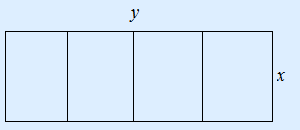Differentiation and integration » Optimization
In optimization problems you are asked for the maximum or minimum value of a given variable. For example, you may be asked about the maximum size of the contents of a box or the minimum cost of the fences of a plot.
When solving algebraic optimization problems, follow the schedule underneath:| 1. | Deduce from the question which two variables play a role. |
| 2. | Make a formula for both variables. |
| 3. | Rearrange the formula of the variable which is not asked. |
| 4. | Substitute the rearranged formula in the other. |
| 5. | Differentiate and solve the equation to zero. Because in the maximum or minimum the gradient is zero. |
| 6. | The found value must sometimes be filled in the other formula to find the other dimension or to calculate the minimum cost. |
Example 1
A farmer wants a rectangular piece of land fenced with barbed wire. He also wants this piece of land divided into 4 equal pieces. See the drawing below.

The farmer has a roll of barbed wire with a length of 360 metres. With which measurements will he get the maximum area?
| 1. | The variables here are the length of the barbed wire and the area. | ||||||||
| 2. | length = 2y + 5x and area = xy. | ||||||||
| 3. | The length of the barbed wire is 360 metres. The formula will become: 360 = 2y + 5x. When you rearrange the formula to express x in terms of y you will get: x = –0,4y + 72 (you subtract 2y and divide by 5) | ||||||||
| 4. | When you substitute x in the other formula by this expression you will get: area = (–0,4y + 72)y Removing the brackets will give you: –0,4y2 + 72y. | ||||||||
| 5. | In order to calculate the dimensions, where you will have the maximum area, this formula is to be differentiated and solved to zero:
| ||||||||
| 6. | In order to calculate the x-value we fill in the y-value in the formula for the length:
|
Example 2
A farmer is fencing off a rectangular piece of land. He also wants this land divided into 4 equal pieces. The fence at the edges of his land he uses a fence of 20 euros per metre. The other pieces cost 10 euros per metre fence. See the drawing below.

The farmer wants a pice of land measuring 480 square metres. With wich measurements can he minimalize his costs?
| 1. | The variables are area and costs. | ||||||||
| 2. | area = xy and costs = 20y + 20y + 20x + 20x + 10x + 10x + 10x = 40y + 70x. | ||||||||
| 3. | The area is 480 metres, filling this in will give you: 480 = xy. Rearranging gives you: x = 480y . | ||||||||
| 4. | Substituting this formula for x gives you: costs = 40y + 70  480y 480y = 40y + 33600y = 40y + 33600y–1 = 40y + 33600y = 40y + 33600y–1 | ||||||||
| 5. | To calculate for which value the costs are minimum we differentiate and solve the differentiated formula to zero:
| ||||||||
| 6. | If you fill in this y-value in the formula of the area, the x-value can be calculated. x = 48029.0 ≈ 16.6 metres. |